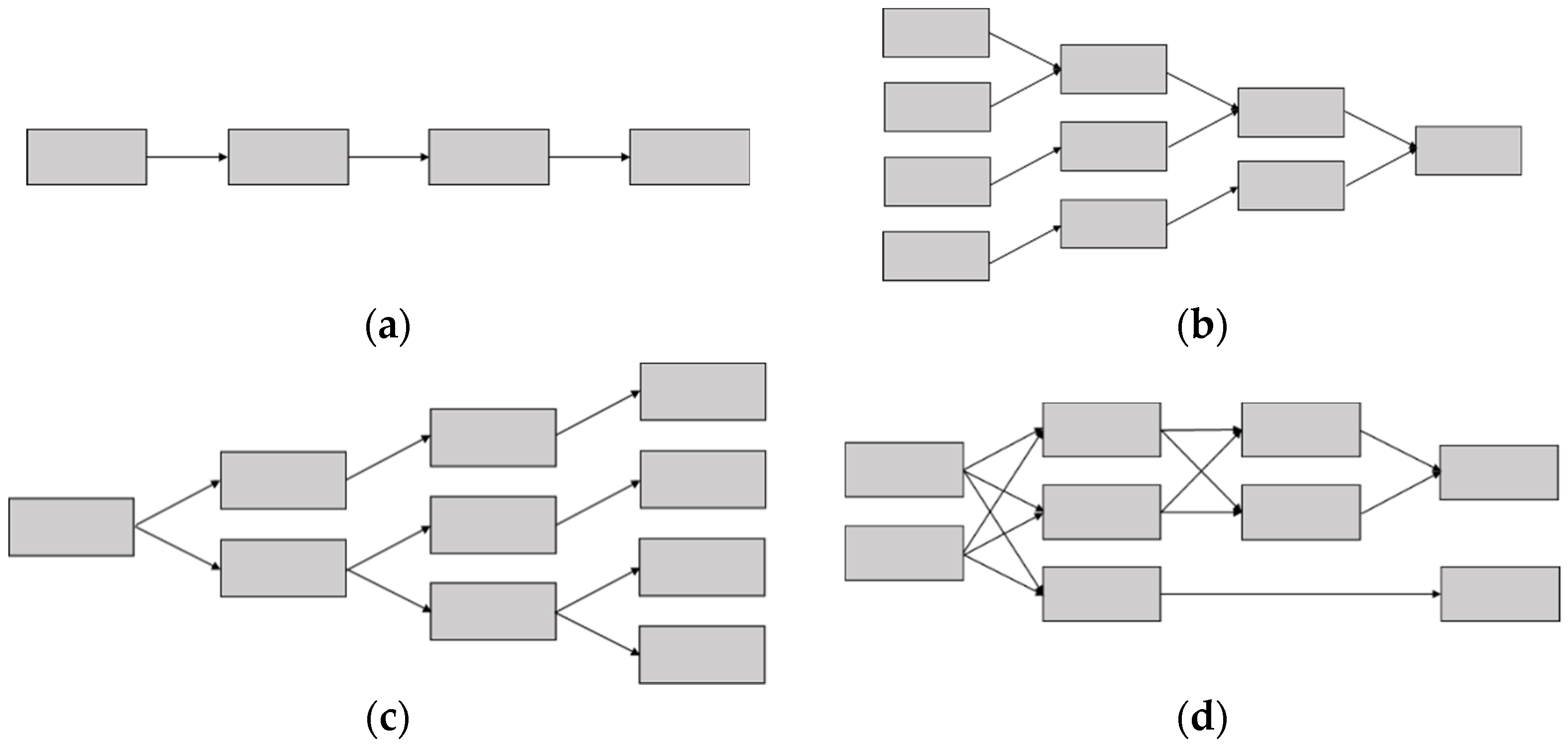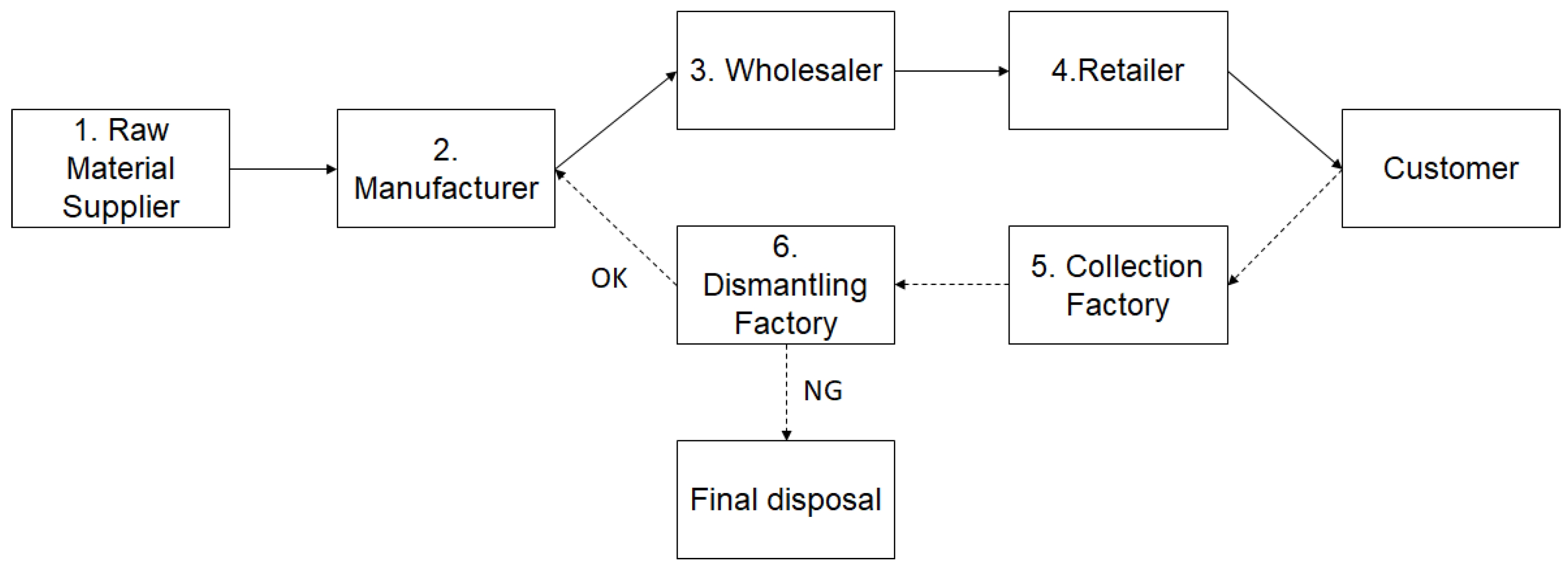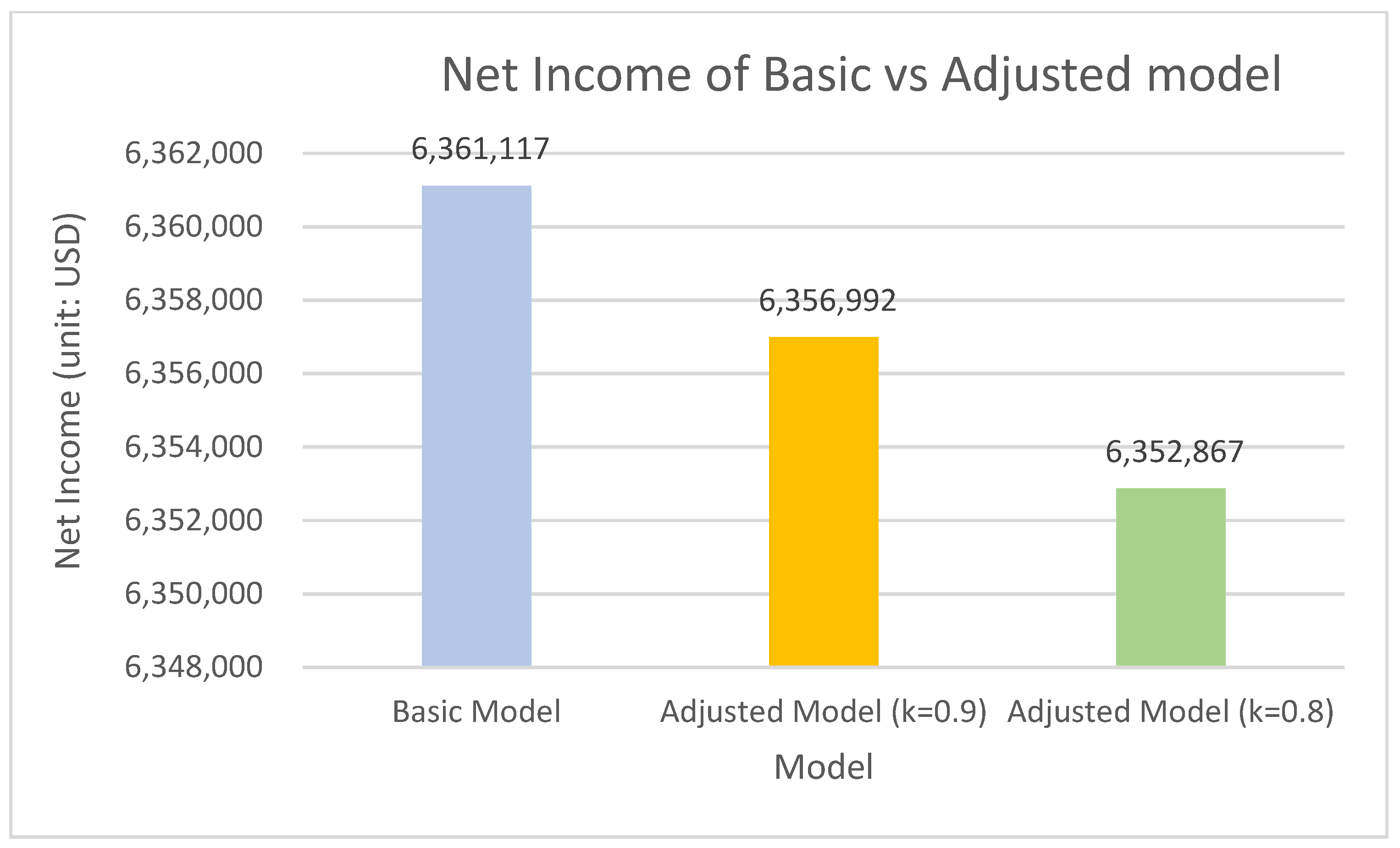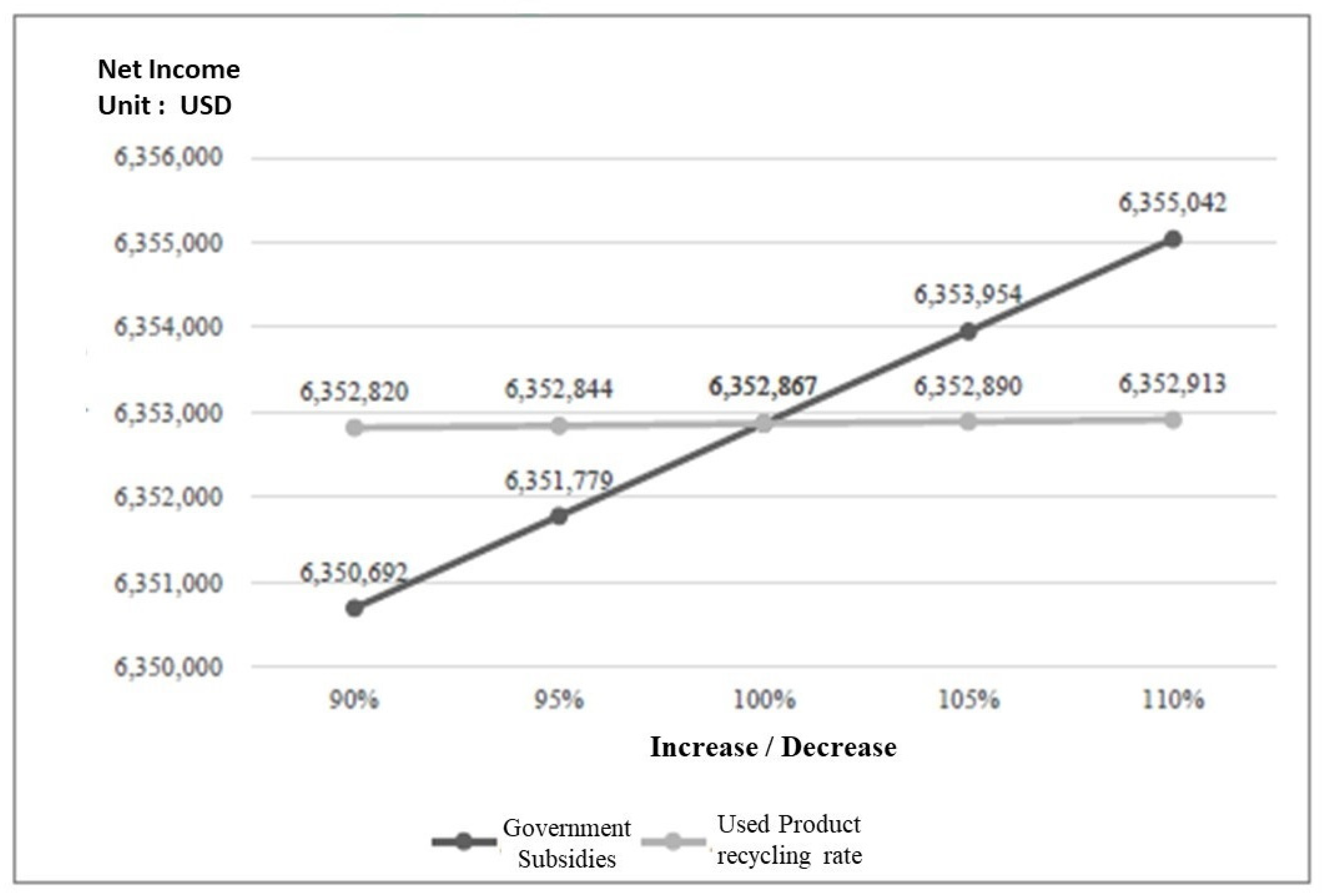Integrated Operational Model of Green Closed-Loop Supply Chain
Abstract
:1. Introduction and Background
1.1. Green Supply Chain Management
1.2. Closed-Loop Supply Chain
1.3. Multi-Level System
2. Methodology
2.1. Assumptions and Notations
- The end customer’s product demand is known and constant.
- The model considers a single product only.
- Out of stock is not allowed.
- The facility and inventory capacities are known and constant.
- The rework rate of used products, which is the proportion of used products that can be reworked in a dismantling factory (wholesaler), is known.
- The used product recycling rate, which is the ratio of used products recycled by end customers, is known.
- The production defect rate, which is the proportion of defective products in the manufacturer’s production process, is known.
- The conversion rate of raw materials and products, which is the amount of raw materials that can be broken down for a unit of used product, is known.
- The time frame is unlimited.
2.2. Mathematical Models
2.2.1. Objective Function
2.2.2. Revenue and Costs
- AR is total revenue. It includes forward and reverse supply chain revenues, as well as government subsidy income, that is, the subsidy received from recycling used products. The subsidy targets are collection factories (retailers) and dismantling factories (wholesalers).
- APC is total purchase cost. It includes the cost of raw materials, the purchase cost of raw materials, the purchase cost of used materials after disassembly, and the purchase cost of products.
- AMC is total manufacturing cost. It includes manufacturing cost and heavy industry costs.
- AIC is total inventory cost. It includes raw material inventory cost, product inventory cost, and storage costs of unprocessed and processed used products.
- ATC is total transportation cost. It includes the transportation cost of forward and reverse supply chains, and the transportation cost from dismantling factories to the final disposal site.
- ACC is the total collection cost of obtaining used products from customers at collection factories.
- ALC sums up the labor cost at each level.
- AFC is the total cost of the final disposal of used products.
- ATTC is total disposal cost of used products. It includes the processing cost of all used products in the reverse supply chain, except the final disposal.
2.2.3. Adjusted Model
3. Results
3.1. Net Income Comparison between the Two Models
3.2. Government Subsidy
3.3. Used Product Recycling Rate
3.4. Government Subsidy and Used Product Recycling Rate
4. Discussion
- The net income of the basic model is USD 6,361,117, and the net income of the adjusted model is USD 6,359,182 when k = 0.9. Therefore, considering the difference in the quality of used raw materials, the decrease in used raw materials that can be recycled and remanufactured causes a decline in the overall net income of the supply chain.
- Considering that the reproducibility rate (k) of used raw materials may vary due to differences in the quality of recycled products, the parameter is adjusted to study its impact. This study finds that net income decreases with the reduction in k. The reason is when the availability of used raw material decreases, the number of finished products that can be produced also decreases and causes the net profit to decrease as well. The experimental results show that if k is 0.9, the maximum net profit is USD 6,356,992; if k is 0.8, the maximum net profit is USD 6,352,867.
- Both government subsidy (S) and used product recycling rate (β) have a positive impact on the overall net income. The results show that as government subsidy increases, the net income in the supply chain system increases as well. When government actively promotes the concept of environmental protection, environmentally conscious green companies can receive more government subsidy. In addition, when the recycling rate of used products increases, it will also have an impact on net income. Increased willingness to recycle and reuse used products can effectively reduce the company’s production costs, thereby increasing net profit. Government subsidy is found to have a more significant impact on net income than used product recycling rates. Therefore, in the supply chain model constructed in this study, government subsidy can be regarded as a key decision-making parameter.
5. Conclusions
Author Contributions
Funding
Institutional Review Board Statement
Informed Consent Statement
Conflicts of Interest
Abbreviations
| Cost | |
| Cr | Unit cost of raw materials |
| Cp | Unit purchase cost |
| Cm | Unit manufacturing cost |
| Cre | Unit rework cost of defective products |
| Cir | Unit storage cost of raw materials |
| Ci | Unit product inventory cost |
| Cint | Unit storage cost of unprocessed used products |
| Cit | Unit storage cost of processed used products |
| Ct | Unit transportation cost |
| Cc | Unit collection cost of used products collected from end customers |
| Cl | Unit labor cost |
| Ctr | Unit processing cost of used products |
| Cf | Unit cost of final disposal |
| Ci,j | The cost from level i to level j in the forward or reverse supply chain |
| Revenue | |
| Ri,j | Unit income from the i-th layer to the j-th layer in the forward or reverse supply chain |
| S | Unit subsidy provided by the government |
| Quantity | |
| Qr | Quantity of raw materials |
| Qp | Purchase quantity |
| Qm | Manufacturing quantity |
| Qre | Quantity of products returned by wholesalers that can be reworked |
| Qir | Inventory quantity of raw materials |
| Qi | Product inventory quantity |
| Qint | The inventory quantity of unprocessed used products |
| Qit | The inventory quantity of processed used products |
| Ql | Number of services |
| Qtr | Processing quantity of used products |
| Qf | Quantity of disposed products |
| Qi,j | The number of logistics from the i-th layer to the j-th layer in the forward or reverse supply chain |
| Facility capacity | |
| Si | Product inventory capacity |
| Sir | Facility capacity of raw material inventory |
| Sit | Facility capacity of processed used product inventory |
| Sint | Facility capacity of unprocessed used product inventory |
| Other parameters | |
| D | End customer demand |
| t | Time |
| α | Rework rate of used products |
| β | Used product recycling rate |
| γ | Conversion rate of raw materials and products |
| δ | Production defect rate |
References
- Pearce, D. Blueprint 2: Greening the World Economy; Routledge: London, UK, 2013. [Google Scholar]
- Tiwari, A.; Chang, P.-C.; Tiwari, M.; Kandhway, R. A Hybrid Territory Defined evolutionary algorithm approach for closed loop green supply chain network design. Comput. Ind. Eng. 2016, 99, 432–447. [Google Scholar] [CrossRef]
- Lambert, D.M.; Cooper, M.C. Issues in supply chain management. Ind. Mark. Manag. 2000, 29, 65–83. [Google Scholar] [CrossRef]
- Narasimhan, R.; Carter, J.R. Environmental Supply Chain Management; Center for Advanced Purchasing Studies: Tempe, AZ, USA, 1998. [Google Scholar]
- Ashley, S. Designing for the environment. Mech. Eng. CIME 1993, 115, 52–56. [Google Scholar]
- Pagell, M.; Yang, C.L.; Krumwiede, D.W.; Sheu, C. Does the competitive environment influence the efficacy of investments in environmental management? J. Supply Chain Manag. 2004, 40, 30–39. [Google Scholar] [CrossRef]
- Diabat, A.; Govindan, K. An analysis of the drivers affecting the implementation of green supply chain management. Resour. Conserv. Recycl. 2011, 55, 659–667. [Google Scholar] [CrossRef]
- Lin, R.-J. Using fuzzy DEMATEL to evaluate the green supply chain management practices. J. Clean. Prod. 2013, 40, 32–39. [Google Scholar] [CrossRef]
- Sheu, J.-B.; Chou, Y.-H.; Hu, C.-C. An integrated logistics operational model for green-supply chain management. Transp. Res. Part E Logist. Transp. Rev. 2005, 41, 287–313. [Google Scholar] [CrossRef]
- Pagell, M.; Krumwiede, D.; Sheu, C. Efficacy of environmental and supplier relationship investments—Moderating effects of external environment. Int. J. Prod. Res. 2007, 45, 2005–2028. [Google Scholar] [CrossRef]
- Song, H.; Gao, X. Green supply chain game model and analysis under revenue-sharing contract. J. Clean. Prod. 2018, 170, 183–192. [Google Scholar] [CrossRef]
- Bhattacharya, R.; Kaur, A.; Amit, R. Price optimization of multi-stage remanufacturing in a closed loop supply chain. J. Clean. Prod. 2018, 186, 943–962. [Google Scholar] [CrossRef]
- Akçalı, E.; Çetinkaya, S. Quantitative models for inventory and production planning in closed-loop supply chains. Int. J. Prod. Res. 2011, 49, 2373–2407. [Google Scholar] [CrossRef]
- Garg, K.; Kannan, D.; Diabat, A.; Jha, P. A multi-criteria optimization approach to manage environmental issues in closed loop supply chain network design. J. Clean. Prod. 2015, 100, 297–314. [Google Scholar] [CrossRef]
- Özkır, V.; Başlıgil, H. Multi-objective optimization of closed-loop supply chains in uncertain environment. J. Clean. Prod. 2013, 41, 114–125. [Google Scholar] [CrossRef]
- Talaei, M.; Moghaddam, B.F.; Pishvaee, M.S.; Bozorgi-Amiri, A.; Gholamnejad, S. A robust fuzzy optimization model for carbon-efficient closed-loop supply chain network design problem: A numerical illustration in electronics industry. J. Clean. Prod. 2016, 113, 662–673. [Google Scholar] [CrossRef]
- Guide, V.D.R., Jr.; Van Wassenhove, L.N. The Evolution of Closed-Loop Supply Chain Research. Oper. Res. 2009, 57, 10–18. [Google Scholar] [CrossRef]
- Howard, C. Real-Time Allocation Decisions in Multi-Echelon Inventory Control; Lund University: Lund, Sweden, 2013. [Google Scholar]
- Cohen, M.A.; Kleindorfer, P.R.; Lee, H.L. Optimal stocking policies for low usage items in multi-echelon inventory systems. Nav. Res. Logist. Q. 1986, 33, 17–38. [Google Scholar] [CrossRef]
- Chen, F. Optimal policies for multi-echelon inventory problems with batch ordering. Oper. Res. 2000, 48, 376–389. [Google Scholar] [CrossRef]
- Federgruen, A. Centralized planning models for multi-echelon inventory systems under uncertainty. Handb. Oper. Res. Manag. Sci. 1993, 4, 133–173. [Google Scholar]
- Chiu, H.N.; Huang, H.L. A multi-echelon integrated JIT inventory model using the time buffer and emergency borrowing policies to deal with random delivery lead times. Int. J. Prod. Res. 2003, 41, 2911–2931. [Google Scholar] [CrossRef]
- Gümüs, A.T.; Güneri, A.F. Multi-echelon inventory management in supply chains with uncertain demand and lead times: Literature review from an operational research perspective. Proc. Inst. Mech. Eng. Part B J. Eng. Manuf. 2007, 221, 1553–1570. [Google Scholar] [CrossRef]
- Khalifehzadeh, S.; Seifbarghy, M.; Naderi, B. A four-echelon supply chain network design with shortage: Mathematical modeling and solution methods. J. Manuf. Syst. 2015, 35, 164–175. [Google Scholar] [CrossRef]







| Government Subsidy | −10% | −5% | Literature | 5% | 10% |
| 7.83 | 8.265 | 8.7 | 9.135 | 9.57 |
| Net Income Unit: USD | Used Raw Material Reproducibility Rate (k) is 0.9 | Used Raw Material Reproducibility Rate (k) is 0.8 | |||
|---|---|---|---|---|---|
| Increase/ Decrease | Parameter: Government Subsidies | Parameter: Used Product Recycling Rate | Parameter: Government Subsidies | Parameter: Used Product Recycling Rate | |
| −10% | 6,354,817 | 6,356,945 | 6,355,692 | 6,352,820 | |
| −5% | 6,355,904 | 6,356,969 | 6,351,779 | 6,352,844 | |
| 0% | 6,356,992 | 6,356,992 | 6,352,867 | 6,352,867 | |
| +5% | 6,358,079 | 6,357,015 | 6,353,954 | 6,352,890 | |
| +10% | 6,359,167 | 6,357,038 | 6,355,042 | 6,352,913 | |
Publisher’s Note: MDPI stays neutral with regard to jurisdictional claims in published maps and institutional affiliations. |
© 2021 by the authors. Licensee MDPI, Basel, Switzerland. This article is an open access article distributed under the terms and conditions of the Creative Commons Attribution (CC BY) license (https://creativecommons.org/licenses/by/4.0/).
Share and Cite
Chiu, C.-Y.; Cheng, C.-Y.; Wu, T.-Y. Integrated Operational Model of Green Closed-Loop Supply Chain. Sustainability 2021, 13, 6041. https://doi.org/10.3390/su13116041
Chiu C-Y, Cheng C-Y, Wu T-Y. Integrated Operational Model of Green Closed-Loop Supply Chain. Sustainability. 2021; 13(11):6041. https://doi.org/10.3390/su13116041
Chicago/Turabian StyleChiu, Chui-Yu, Chen-Yang Cheng, and Ting-Ying Wu. 2021. "Integrated Operational Model of Green Closed-Loop Supply Chain" Sustainability 13, no. 11: 6041. https://doi.org/10.3390/su13116041





